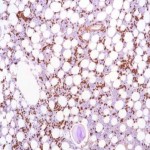Types of Amyloidosis
Amyloidosis is a group of diseases that share a common feature of amyloid fibril deposition in various organs and tissues. The systemic amyloidosis types are all very different from each other with respect to the biochemical nature of the amyloid deposits and the precursor amyloid protein. Some are acquired and others are inherited. Some types share clinical features of the disease with respect to organ involvement and dysfunction. It is crucial to define the precursor amyloidogenic protein and accurately type amyloid deposits to be able to offer accurate treatment, assess prognosis and suggest genetic counseling as needed.
AL amyloidosis (Primary)

AL (immunoglobulin light chain) amyloidosis is an acquired plasma cell disorder in which a monoclonal immunoglobulin light chain is produced in the bone marrow and usually found in the blood or urine. AL amyloidosis occasionally occurs with multiple myeloma, lymphoma, or Waldenstorm’s macroglobulinemia. The amyloid fibrils in this type of amyloidosis are made up of immunoglobulin light chain proteins (kappa or lambda). Symptoms can occur in any organ of the body and include heart failure, protein in the urine or kidney failure, enlarged liver, neuropathy or enlarged tongue. Treatment with chemotherapy including high dose chemotherapy with stem cell transplantation, and other agents, can put the bone marrow disease in remission, leading to improvement in organ dysfunction and protect the target organs. This is one of the most common type of amyloidosis diagnosed in the United States.
AA amyloidosis (Secondary)
AA amyloidosis is caused by a chronic infection or an inflammatory disease such as rheumatoid arthritis, familial Mediterranean fever (FMF), osteomyelitis, or granulomatous ileitis. Infection or inflammation causes elevation of an acute phase protein, SAA, a portion of which deposits as amyloid fibrils. Therefore, it is termed AA amyloidosis. AA amyloidosis usually begins as disease in the kidneys, but other organs can be affected. Medical or surgical treatment of the underlying chronic infection or inflammatory disease can slow down or stop the progression of this type of amyloidosis.
ATTR amyloidosis
ATTR amyloidosis (ATTRm or ATTRwt)

There are several types of inherited amyloidoses, the most common of which is caused by a mutation in the transthyretin (TTR) gene that produces abnormal transthyretin protein. The abnormal TTR protein deposits as amyloid fibrils: Hence, it is termed ATTR amyloidosis. Symptoms of disease are usually neuropathy and cardiomyopathy and occur in mid to late life. ATTR amyloidosis is found in families of nearly every ethnic background. More than 100 different mutations in transthyretin are known and most cause amyloidosis. ATTR can also occur with the wild type unmutated TTR protein, usually causing cardiomyopathy in older men; this was formerly termed “senile systemic amyloidosis” but now is known as ATTRwt amyloidosis. Treatment options include TTR stabilizers (Diflunisal or Tafamidis), or gene silencers or TTR production or liver transplantation.
Other hereditary amyloidoses
There are other gene mutations that produce proteins that cause amyloidosis. These are very rare. They include apolipoprotein A-I (AApoAI), apolipoprotein A-II (AApoAII), gelsolin (AGel), fibrinogen (AFib), and lysozyme (ALys). A protein known as Lect2 can also cause amyloidosis; it is not clear if this is inherited or not.
Beta-2 Microglobulin amyloidosis (Abeta2m)
Beta-2 microglobulin amyloidosis is caused by chronic renal failure and often occurs in patients who are on dialysis for many years. Amyloid deposits are made of the beta-2 microglobulin protein that accumulated in tissues, particularly around joints, when it cannot be excreted by the kidney because of renal failure.
Localized amyloidosis (ALoc)
There are many types of localized amyloidoses. Localized amyloid deposits in the airway (trachea or bronchus), eye, or urinary bladder are often caused by local production of immunoglobulin light chains, not originating in the bone marrow. Localized AL can be treated with radiation therapy, and it and other localized forms sometimes are amenable to surgery. Other localized types of amyloidosis are associated with endocrine proteins, or proteins produced in the skin, heart, and other sites. These usually do not become systemic.